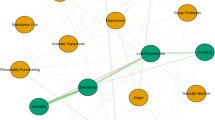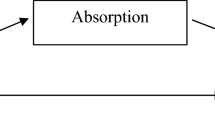Abstract
Poker-machine gamblers have been demonstrated to report increases in the urge to gamble following exposure to salient gambling cues. However, the processes which contribute to this urge to gamble remain to be understood. The present study aimed to investigate whether changes in the conscious experience of visual imagery, rationality and volitional control (over one’s thoughts, images and attention) predicted changes in the urge to gamble following exposure to a gambling cue. Thirty-one regular poker-machine gamblers who reported at least low levels of problem gambling on the Problem Gambling Severity Index (PGSI), were recruited to complete an online cue-reactivity experiment. Participants completed the PGSI, the visual imagery, rationality and volitional control subscales of the Phenomenology of Consciousness Inventory (PCI), and a visual analogue scale (VAS) assessing urge to gamble. Participants completed the PCI subscales and VAS at baseline, following a neutral video cue and following a gambling video cue. Urge to gamble was found to significantly increase from neutral cue to gambling cue (while controlling for baseline urge) and this increase was predicted by PGSI score. After accounting for the effects of problem-gambling severity, cue-reactive visual imagery, rationality and volitional control significantly improved the prediction of cue-reactive urge to gamble. The small sample size and limited participant characteristic data restricts the generalizability of the findings. Nevertheless, this is the first study to demonstrate that changes in the subjective experience of visual imagery, volitional control and rationality predict changes in the urge to gamble from neutral to gambling cue. The results suggest that visual imagery, rationality and volitional control may play an important role in the experience of the urge to gamble in poker-machine gamblers.


Similar content being viewed by others
References
Ashrafioun, L., McCarthy, A., & Rosenberg, H. (2012). Methods of assessing craving to gamble: A narrative review. Psychology of Addictive Behaviors, 26, 536–549. doi:10.1037/a0026367.
Australian Government. (2014). Problem gambling. Retrieved from http://www.problemgambling.gov.au/.
Baudinet, J., & Blaszczynski, A. (2013). Arousal and gambling mode preference: A review of the literature. Journal of Gambling Studies, 29, 343–358. doi:10.1007/s10899-012-9304-2.
Blaszczynski, A. (1999). Pathological gambling and obsessive-compulsive spectrum disorders. Psychological Reports, 84(1), 107–113. doi:10.2466/pr0.84.1.107-113.
Blaszczynski, A., & Nower, L. (2002). A pathways model of problem and pathological gambling. Addiction, 97, 487–499. doi:10.1046/j.1360-0443.2002.00015.x.
Dadds, M., Hawes, D., Schaefer, B., & Vaka, K. (2004). Individual differences in imagery and reports of aversions. Memory, 12(4), 462–466. doi:10.1080/09658210444000070.
Delfabbro, P. H. (2012). Australasian gambling review. Fifth edition (1992–2011). Adelaide: Independent Gambling Authority. Retrieved from http://www.jogoremoto.com/docs/extra/hDYc5T.pdf.
Delfabbro, P. H., & Winefeld, A. H. (2000). Predictors of irrational thinking in regular slot machine gamblers. The Journal of Psychology, 134(2), 117–128. doi:10.1080/00223980009600854.
Dickerson, M. (2004). Analysis of clients presenting to problem gambling counseling services, July 2001 to June 2002, client and services analysis report no. 8. Melbourne: Victorian Government, Department of Human Resources.
Faul, F., Erdfelder, E., Lang, A. G., & Buchner, A. (2007). G*Power 3: A flexible statistical power analysis program for the social, behavioral, and biomedical sciences. Behavior Research Methods, 39(2), 175–191.
Ferris, J., & Wynne, H. (2001). The Canadian problem gambling index: User manual. Ottawa: Canadian Centre on Substance Abuse.
Freidenberg, B. M., Blanchard, E. B., Wulfert, E., & Malta, L. S. (2002). Changes in physiological arousal to gambling cues among participants in motivationally enhanced cognitive–behavior therapy for pathological gambling: A preliminary study. Applied Psychophysiology and Biofeedback, 27(4), 251–260.
Gee, P., Coventry, K. R., & Birkenhead, D. (2005). Mood state and gambling: Using mobile telephones to track emotions. British Journal of Psychology, 96(1), 53–66. doi:10.1348/000712604X15536.
Gelman, A., Shor, B., Bafumi, J., & Park, D. (2007). Rich state, poor state, red state, blue state: What’s the matter with Connecticut? Quarterly Journal of Political Science, 2, 345–367. doi:10.1561/100.00006026.
Holmes, E. A., Iyadurai, L., Jacob, G. A., & Hales, S. (2015). Mental imagery in psychological disorders. Emerging trends in the social and behavioral sciences. Chichester: Wiley. doi:10.1002/9781118900772.etrds0216.
Indovina, I., Robbins, T. W., Núñez-Elizalde, A. O., Dunn, B. D., & Bishop, S. J. (2011). Fear-conditioning mechanisms associated with trait vulnerability to anxiety in humans. Neuron, 69(3), 563–571.
Jacobs, D. F. (1988). Evidence for a common dissociative-like reaction among addicts. Journal of Gambling Behavior, 4, 27–37. doi:10.1007/BF01043526.
Kambouropoulos, N., & Rock, A. J. (2010). Extraversion and altered state of awareness predict alcohol cue-reactivity. Journal of Individual Differences, 31(4), 178–184. doi:10.1027/1614-0001/a000026.
Kemps, E., & Tiggemann, M. (2015). A role for mental imagery in the experience and reduction of food cravings. Frontiers in Psychiatry, 5, 193. doi:10.3389/fpsyt.2014.00193.
Kilts, C. D., Gross, R. E., Ely, T. D., & Drexler, K. P. (2004). The neural correlates of cue-induced craving in cocaine-dependent women. American Journal of Psychiatry, 161, 223–241. doi:10.1176/appi.ajp.161.2.233.
Knaeble, B., & Dutter, S. (2015). Reversals of least-squares estimates and model-independent estimation for directions of unique effects. Methodology (stat.ME). arXiv:1503.02722.
Kushner, M. G., Abrams, K., Donahue, C., Thuras, P., Frost, R., & Kim, S. W. (2007). Urge to gamble in problem gamblers exposed to a casino environment. Journal of Gambling Studies, 23(2), 121–132. doi:10.1007/s10899-006-9050-4.
Ladouceur, R., Gaboury, A., Bujold, A., Lachance, N., & Tremblay, S. (1991). Ecological validity of laboratory studies of videopoker gaming. Journal of Gambling Studies, 7(2), 109–116. doi:10.1007/BF01014526.
Ladouceur, R., Sylvain, C., Boutin, C., Lachance, S., Doucet, C., Leblond, J., et al. (2001). Cognitive treatment of pathological gambling. The Journal of Nervous and Mental Disease, 189, 774–780.
MacLaren, V. V., Fugelsang, J. A., Harrigan, K. A., & Dixon, M. J. (2012). Effects of impulsivity, reinforcement sensitivity, and cognitive style on pathological gambling symptoms among frequent slot machine players. Personality and Individual Differences, 52, 390–394. doi:10.1016/j.paid.2011.10.044.
Martin, R. J., Usdan, S., Nelson, S., Umstattd, M. R., LaPlante, D., Perko, M., et al. (2010). Using the theory of planned behavior to predict gambling behavior. Psychology of Addictive Behaviors, 24(1), 89. doi:10.1037/a0018452.
McCormick, J., Delfabbro, P., & Denson, L. A. (2012). Psychological vulnerability and problem gambling: An application of Durand Jacobs’ general theory of addictions to electronic gaming machine playing in Australia. Journal of Gambling Studies, 28, 665–690. doi:10.1007/s10899-011-9281-x.
McKeith, C. F. A., Rock, A. J., & Clark, G. I. (2016). Trait mindfulness, problem-gambling severity, altered state of awareness and urge to gamble in poker-machine gamblers. Journal of Gambling Studies. doi:10.1007/s10899-016-9635-5.
Monti, P. M., Binkoff, J. A., Abrams, D. B., Zwick, W. R., Nirenberg, T. D., & Liepman, M. R. (1987). Reactivity of alcoholics and nonalcoholics to drinking cues. Journal of Abnormal Psychology, 96, 122–126. doi:10.1037/0021-843X.96.2.122.
Oakes, J., Pols, R., Battersby, M., Lawn, S., Pulvirenti, M., & Smith, D. (2012). A focus group study of predictors of relapse in electronic gaming machine problem gambling, part 1: Factors that ‘push’ towards relapse. Journal of Gambling Studies, 28, 451–464. doi:10.1007/s10899-011-9264-y.
Oksanen, E. H. (1987). On sign changes upon deletion of a variable in linear regression analysis. Oxford Bulletin of Economics and Statistics, 49, 227–229.
Pekala, R. J. (1991). Quantifying consciousness: An empirical approach. New York: Plenum.
Pekala, R. J., Steinberg, J., & Kumar, C. K. (1986). Measurement of phenomenological experience: Phenomenology of consciousness inventory. Perceptual and Motor Skills, 63, 983–989. doi:10.2466/pms.1986.63.2.983.
Pekala, R. J., & Wenger, C. F. (1983). Retrospective phenomenological assessment: Mapping consciousness in reference to specific stimulus conditions. Journal of Mind and Behavior, 4(2), 247–274. Retrieved from http://psycnet.apa.org.
Productivity Commission. (2010). Gambling, Report no. 50, Canberra.
Rock, A. J., & Kambouropoulos, N. (2007). Toward a phenomenology of urge to drink: A future prospect for the cue-reactivity paradigm. North American Journal of Psychology, 9(2), 387–406.
Rock, A. J., & Kambouropoulos, N. (2008). Conceptualizing craving: Extrapolations from consciousness studies. North American Journal of Psychology, 10(1), 127–146.
Rock, A. J., & Kambouropoulos, N. (2012). The phenomenology of alcohol cue-reactivity: A partial replication and extension. Imagination, Cognition and Personality, 32(1), 75–93. doi:10.2190/IC.32.1.f.
Rohsenow, D. J., & Niaura, R. S. (1999). Reflections on the state of cue-reactivity theories and research. Addiction, 94(3), 343–344. Retrieved from www.ncbi.nlm.nih.gov.
Sodano, R., & Wulfert, E. (2010). Cue reactivity in active pathological, abstinent pathological, and regular gamblers. Journal of Gambling Studies, 26, 53–65. doi:10.1007/s10899-009-9146-8.
Tavares, H., Zilberman, M. L., & el-Guebaly, N. (2003). Are there cognitive and behavioural approaches specific to the treatment of pathological gambling? Canadian Journal of Psychiatry, 48, 22–27.
Tiffany, S. T., & Drobes, D. J. (1990). Imagery and smoking urges: The manipulation of affective content. Addictive Behaviors, 15(6), 531–539. doi:10.1016/0306-4603(90)90053-Z.
Tricker, C., Rock, A. J., & Clark, G. I. (2016). Cue-reactive altered state of consciousness mediates the relationship between problem-gambling severity and cue-reactive urge in poker-machine gamblers. Journal of Gambling Studies, 32, 661–674. doi:10.1007/s10899-015-9549-7.
Visco, I. (1978). On obtaining the right sign of a coefficient estimate by omitting a variable from the regression. Journal of Econometrics, 7, 115–117.
Visco, I. (1988). Again on sign changes upon deletion of a variable from a linear regression. Oxford Bulletin of Economics and Statistics, 50, 225–227.
Walker, M. B. (1992). Irrational thinking among slot machine players. Journal of GamblingStudies, 8, 245–288. doi:10.1007/BF01014652.
Wanner, B., Ladouceur, R., Auclair, A. V., & Vitaro, F. (2006). Flow and dissociation: Examination of mean levels, cross-links, and links to emotional well-being across sports and recreational and pathological gambling. Journal of Gambling Studies, 22(3), 289–304. doi:10.1007/s10899-006-9017-5.
Whiting, S. W., & Dixon, M. R. (2013). Effects of mental imagery on gambling behavior. Journal of Gambling Studies, 29(3), 525–534. doi:10.1007/s10899-012-9314-0.
Wu, A. M., & Tang, C. S. K. (2012). Problem gambling of Chinese college students: Application of the theory of planned behavior. Journal of Gambling Studies, 28(2), 315–324. doi:10.1007/s10899-011-9250-4.
Wulfert, E., Maxson, J., & Jardin, B. (2009). Cue-specific reactivity in experienced gamblers. Psychology of Addictive Behaviors, 23, 731–735. doi:10.1037/a0017134.
Author information
Authors and Affiliations
Corresponding author
Rights and permissions
About this article
Cite this article
Clark, G.I., Rock, A.J., McKeith, C.F.A. et al. Cue-Reactive Rationality, Visual Imagery and Volitional Control Predict Cue-Reactive Urge to Gamble in Poker-Machine Gamblers. J Gambl Stud 33, 807–823 (2017). https://doi.org/10.1007/s10899-016-9650-6
Published:
Issue Date:
DOI: https://doi.org/10.1007/s10899-016-9650-6




